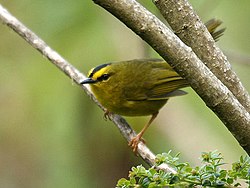| Myiothlypis | |
|---|---|
 | |
| Black-crested warbler (Myiothlypis nigrocristata) | |
| Scientific classification | |
| Kingdom: | Animalia |
| Phylum: | Chordata |
| Class: | Aves |
| Order: | Passeriformes |
| Family: | Parulidae |
| Genus: | Myiothlypis Cabanis, 1851 |
| Type species | |
| Trichas nigrocristatus [1] Lafresnaye, 1840 | |
| Species | |
Many, see text | |
Myiothlypis is a genus of New World warblers, best represented in Central and South America. This is one of only two warbler genera that are well represented in the latter continent. All of these species were formerly placed in the genus Basileuterus .